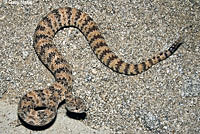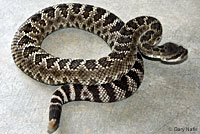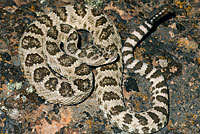Yikes, seven different species of rattlesnakes in California, and Brad is hiking the PCT in Southern California with most of them. An important article describing rattlesnake characteristics, including habitat, range, behavior, diet and predators is cited. However, despite the prevalence of rattlesnakes in California there are other common California snakes, including the Gophersnake, Coachwhip Snake, Sharp-Tailed Snake, King Snake, Racer, Ring-necked Snakes and Gartersnakes. Other excellent snake sites are: Snakes - Mojave Desert Wildlife, Rattlesnakes in California and Photo Index of California Snakes.
 |
| Side Winder |
 |
| Southwestern Speckled Ratlesnake |
 |
| Southern Pacific Rattlesnake |
 |
| Great Basin Rattlesnake |
 | ||
Panamint Rattlesnake
What Can be Done to Prevent a Bite?
Hands,
feet, and ankles are the most common sites for rattlesnake bites. Using
some common sense rules can prevent most snake bites.
|

No comments:
Post a Comment